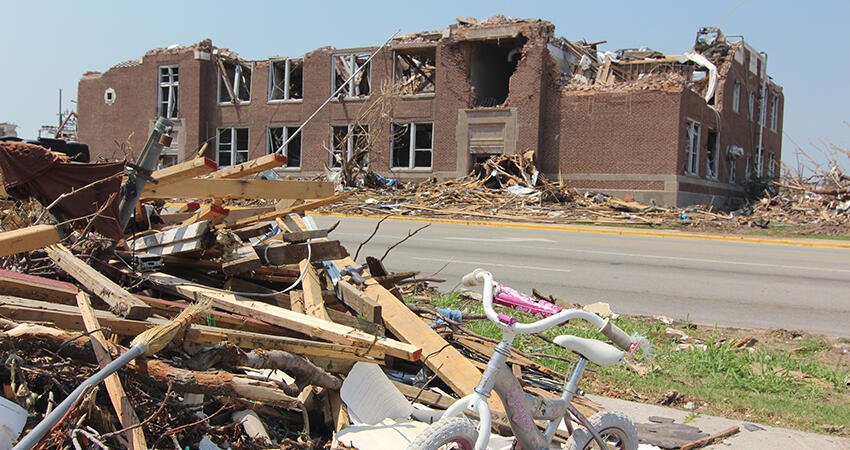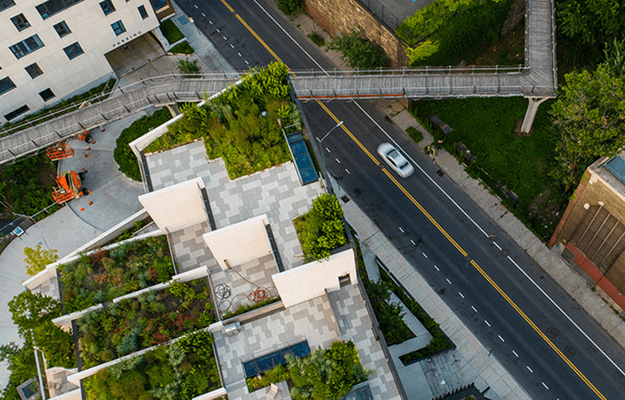
(Dustie/Shutterstock)
What Climate Change Means for Schools and Students
Heat Waves, Snow Days, and More
Across the world, climate change has driven a rapid rise in weather-related disasters. In the past three years, the US has experienced a record number of weather events and disasters that have resulted in hundreds of billions of dollars in total damages.
As events like heat waves, hurricanes, and wildfires become more common, school districts nationwide have had to grapple with learning disruptions and widespread school closures. For schools, and especially their most vulnerable students, being prepared for disasters and other learning disruptions can be key to preserving academic and housing outcomes after the disaster.
How climate change affects schools and neighborhoods
Disasters and severe weather can cause serious damage to school buildings and their surrounding neighborhoods, leading to extended school closures and costly repairs.
When Hurricane Katrina made landfall in 2005, it severely damaged or destroyed 110 of the 126 public schools in New Orleans. The city only completed its last Katrina-related school restoration in March 2023, nearly 18 years later.
In Puerto Rico, in the aftermath of Hurricane Maria in 2017, more than 250 of the island’s 1,100 public schools were closed permanently. In response, the Federal Emergency Management Agency (FEMA) allocated over $2 billion dollars to the Puerto Rico Department of Education for emergency and permanent work projects related to damage from Hurricane Maria.
In 2018, the Camp Fire in California led to school closures for almost a million students and affected more than 1,500 schools, resulting in a collective loss of instruction time equivalent to more than 3,000 school days.
Schools aren’t just facing a higher threat of acute disasters. More chronic climate events, like extreme heat and extended flood seasons, can cause extended school disruptions.
Heat waves, which can have serious negative implications for students’ learning ability, have marked the start of recent school years, prompting school districts across the country to delay their start dates. Other chronic climate events, like prolonged flood seasons, are also concerns for schools. Recent storms led to more than 150 New York schools experiencing flooding, and nationwide, nearly 4 million students live in areas with the highest risk of flooding. Experts say both heatwaves and coastal flooding and flash flooding will increase as climate change warms the planet.
Why some schools and students are disproportionately affected by disasters
Where a student lives can greatly affect the likelihood that their learning will be disrupted by climate change, as well as their school and neighborhood’s ability to respond.
Students from families with low-incomes are more likely to live in areas with high risks for disasters, and the schools that serve these students may also be at higher risk of experiencing a disaster. A report from the Government Accountability Office (GAO) found that school districts that received federal disaster recovery grants served a higher-than-average proportion of students from families with low incomes, students of color, or students with disabilities.
Though districts that receive federal disaster aid may have higher shares of socially vulnerable students, that aid often may not be adequate or even be distributed to the students and families with the greatest needs. The GAO report also found that following a disaster, school districts that serve socially vulnerable communities struggle with inadequate insurance payouts and FEMA grants, which can prolong the recovery process.
For families living in school districts affected by disasters, those with low-incomes and families of color may also lack access to the necessary financial resources needed to recover after a disaster. Several studies have found that wealthier and whiter neighborhoods receive a disproportionate amount of federal dollars after a disaster.
Disasters can also result in schools facing short- and long-term changes in enrollment. Puerto Rico’s public schools were already experiencing declines in student enrollment when Hurricane Maria hit in 2017, and the resulting exodus of more than 100,000 Puerto Ricans who left for the mainland US permanently led to a parallel drop in public school enrollment of more than 40,000 students. New Orleans saw a similar drop in students in the immediate aftermath of Hurricane Katrina, losing over 60 percent of the city’s 65,000 public school students in the year following the hurricane.
These sharp declines in student enrollment are often cited as a main reason for school closures, which disproportionately affect Black and Latine students. These school closures can affect students’ lives in a number of ways, interrupting learning, forcing students to commute further to school, and disrupting students’ mental and emotional health.
What can be done to better prepare schools and students for climate change
When schools must close because of disasters or other weather-related events, students can miss out on significant instruction time. This can leave entire cohorts of students struggling to meet academic proficiency levels, especially those students with learning or accessibility needs, who can be especially vulnerable to educational disruption.
Several strategies can help school districts and families better prepare for climate-related disasters and recovery:
- Improving school infrastructure before disasters to mitigate their negative effects. Many schools lack updated infrastructure, like the 41 percent of school districts that have reported that their heating and air conditioning systems needed an urgent upgrade. These systems are increasingly important as climate change contributes to the increasing frequency of intense heatwaves and extreme cold days.
- Designing school spaces that improve resilience to disasters and climate events. By employing strategies that focus on disaster resilience, schools can help their communities reduce the impact of disasters, recover more quickly, and create safer, more equitable places. This could include projects like the OASIS project in Paris, where previously paved or cemented schoolyards were transformed into “green oases” that helped provide community spaces for respite during heatwaves.
- Proactively developing systems to deal with learning disruptions. By building off many of the remote learning practices used during the COVID-19 pandemic, schools can help minimize lost learning time after a disaster. Strategies like distributing laptops and Wi-Fi hot spots, organizing content into an accessible digital platform, and implementing universal broadband can allow students to continue their learning in the immediate aftermath of a learning disruption.
- Providing families the ability to move out of high-risk areas. Moving even small distances can have significant effects on a family’s risk of experiencing a natural disaster. One study found families who received buyouts from FEMA for flood-prone houses generally moved to neighborhoods that were only a 20-minute drive from their original neighborhood, but their new homes had an average of 60 percent less flood risk.
Allowing schools and families to be better prepared for disasters and improving the response and recovery process after a disaster are key factors in ensuring students and schools can continue to find success.


